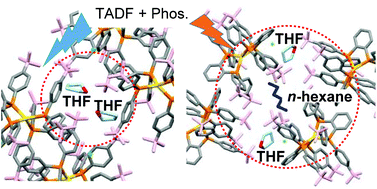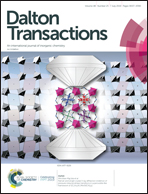Luminescence color alteration induced by trapped solvent molecules in crystals of tetrahedral gold(i) complexes: near-unity luminescence mixed with thermally activated delayed fluorescence and phosphorescence†
Abstract
The tetrahedral gold(I) complex [Au(LtBu)2]Cl 1Cl [LtBu = 1,2-bis[bis(4-tert-butylphenyl)phosphino]benzene], having eight tert-butyl (tBu) groups, was synthesized and characterized. Emission color alteration caused by solvent molecules captured in the crystal lattice of 1Cl was investigated. The recrystallization of 1Cl in mixed solvents of tetrahydrofuran, THF, and various alkanes afforded two single crystals: 1Cl·THF (1BG), presenting intense blue-green luminescence with an emission peak wavelength, λmax, = 507 nm and 1Cl·THF·0.5n-hexane·H2O (1OR), exhibiting weak orange luminescence with λmax = 625 nm. The emission quantum yields, ΦPL, of the two complexes were 0.95 and 0.06, respectively. X-ray structural analysis revealed that all the solvent molecules captured in the crystal were located inside the spaces surrounded by the tBu groups of the 1+ cation. Further, an n-hexane molecule in 1OR was found to be sandwiched between two 1+ cations via CH/π interactions. The structure of 1Cl in 1OR could be distorted by the n-hexane molecule incorporated in the crystal, leading to the red-shift of the emission peak wavelength and the low quantum efficiency of 1OR over that of 1BG. On the other hand, [Au(L)2]Cl [L = 1,2-bis(diphenylphosphino)benzene], having no peripheral tBu groups, was unable to incorporate the solvent molecules in the crystal by recrystallization from the mixed solvents, and thus, the crystal solely yielded intense blue light emission. The results revealed that the tBu groups of the peripheral phenyl units are essential for the luminescence color alteration caused by the incorporation of organic solvent molecules into the crystal lattice. Finally, studies on the emission spectra and quantum yields in the temperature range 77–293 K revealed that luminescence from both 1BG and 1OR was composed of phosphorescence and thermally activated delayed fluorescence.



 Please wait while we load your content...
Please wait while we load your content...